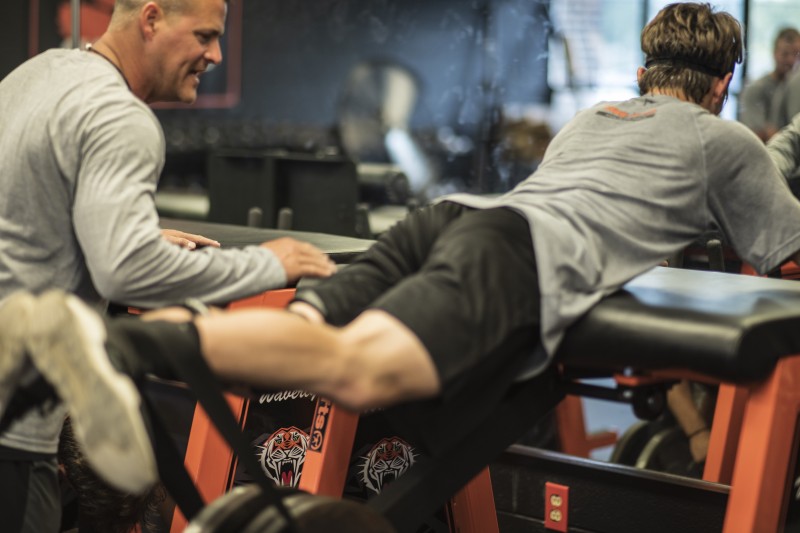
The summer is here — the greatest time of the year for strength coaches. The position coaches are on vacation and you have eight blissful weeks of training your athletes your way. Time to dust off the tried-and-true workouts and input some of the new things you have been researching the last few months. It is like writing a recipe for success: putting all the ingredients together to build a lean, mean, fighting machine.
I have developed my summer philosophy over the last 21 years. Add and subtract, add and subtract, over and over. I know you are doing the same, and that is what makes this profession so great. Everyone has their own personal path they take to lead their teams to success. The only advice I can give, and have given over and over, is to do what you are good at. Never do something just because someone else is doing it. What works at one place will not necessarily work at yours. Different players, facilities, and athletes make sure of that. The important thing is that whatever pathway you have chosen, make sure you do your due diligence, believe in it 100%, and know it inside and out. If you have some questions or are not sure, go ask someone! Verify the path you are on by finding some people that do it that way and ask them the concrete fundamental questions that you have regarding that piece of the puzzle.
RECENT: Your Circle of Trust: Don't Be the Captain of a Ship of Fools
I have made a huge fundamental change this summer in the organization of my plan by switching up the days we do certain things. I know that it doesn’t seem like a big deal, but you know how it is: every decision we make as strength coaches might as well be splitting the atom, especially for someone who has been doing things like this a long time. I am not set in my ways. We have had many successful summers, but I believe there is always a way to improve. There were some things in the back of my head that I thought we could do better, but I had to be sure. I had to believe in the changes all the way or I would not do it. I had to get some answers, so I hit up a bunch of coaches at the convention and burned up some phone lines. I had a great visit with Ole Miss staff. Their scheduling of certain days and exercises were close to some of the changes I wanted to make. After doing this research and really getting to the nitty-gritty of the why and how to make these changes, I decided to pull the trigger. It was one of the best decisions I have ever made. The players are recovering better between workouts, which is letting us do more and more as we keep building towards the season. I would not have made these changes if I did not do my homework and felt comfortable doing it. I trusted my instincts, but still had to verify!
As far as summer programming, I would like to go over how we put together our workouts for this phase of the year. To start, I have some staple things that I will never change. There are certain exercises and runs that we will always do until they take my whistle up to Valhalla. I believe in them and they have worked time and time again. That is the first ingredient: core exercises and runs. Once we have those things in place, the second ingredient to a productive workout program is to add our team needs for this particular summer. These are always different. A team changes every year, so we have to address the biggest weakness that this year’s team may have. How do we find out what it is? We conduct spring evaluations with the coaching and strength staff following the spring semester. Do we need to condition more? Get stronger? Gain size?
Once we figure it out and agree, we move onto the third ingredient: position groups. As a group, are there any common flaws we need to work on? Are there any exercises we should add to help in their performance? Is there an injury that seems to be occurring within a certain group that we could help eliminate? There are many factors for this area, and we do the same thing as above: meet with the coaches and strength coaches to formulate a needs analysis. In this section, we also include the players themselves and ask them what they think they need to work on as a group and what they need to do individually. This is a great time for them to set goals for the summer. I feel that this section is very important because it gives the players some ownership in what they are doing. Even if what they want may seem a little outlandish, I have no problem giving up 10% of programming for them to be invested 100%. Curls won’t kill them, I promise.
MORE: Summer Training for Football (with 8-Week Program)
This brings around the fifth ingredient: getting your players around the right people. We take forever just getting our players paired up with the right strength coach and the right teammates to match personalities. I feel this is very important and an often overlooked portion of putting a workout together. On a team of 100 people, there are going to be many different personalities. They all don’t respond to the same stimuli, so why would you try to have your staff have the same personality and coaching style as you? As long as everyone gets the job done (implementing the workout and getting the most out of the athletes, upholding the standard) then what is the problem? This is the only good thing about the five strength coach rule: you can have two extreme ends of the spectrum, one just a little less extreme on both ends, and one in the middle. You combine those personalities and it will pretty much cover all your athletes. It makes things run much more smoothly for you and your staff. You can concentrate on what really matters: coaching your ass off.
Once you add these five ingredients—core exercises and runs, team goals, position plans, individual goals, and correct grouping—it is time to put it all together. You have a blueprint, and it is time to condense it into a workable plan. My first year as a head strength coach we had six giant white boards filled top to bottom with all this information and then some. It was really anything we could think of. Workouts, exercises, runs, warm-ups — you name it, it was on there. It took us two weeks to distill it down into an eight-week plan that we could implement, believe in, and run efficiently.
Once we did that and all got on the same page, we went to work. It was a lot of fun, as it is now. Following every workout, we meet and discuss any changes, problems, or progress each person’s group may have. Whether we had to switch players, add or change an exercise because they were not ready for it, or move someone up to a faster run group, these things are discussed and changed daily if needed. This keeps us ahead of the curve and enables us to all help each other out. We also have a rule that right is right; there is one right way to do every exercise. If a player in another group is doing something the wrong way and another strength coach sees it, he can step in and correct that athlete. It keeps us on our toes and shows the athletes we just want things done the right way. These are just some tips that I hope can help in some way with your summer preparation. Trust your instincts, verify any questions you may have, and go get after it.












1 Comment